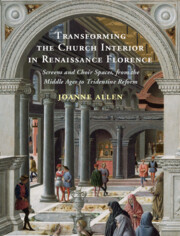‘… This is an excellent, wonderfully researched, and deeply interesting book. I look forward to its publication, and am sure that it will be widely read, frequently cited, and have a major impact in the field.’
Caroline Bruzelius - Duke University
‘There is no question that this is a major contribution and will remain an indispensable resource for a long time to come.’
Marcia Hall - Temple University
‘Joanne Allen’s book is a key contribution to a burgeoning field: study of the crucial role played by screens and choir enclosures - now almost entirely lost - in articulating the space, functioning, and furnishing of medieval and early modern churches. Allen meets the challenge of reconstructing stories of installation, relocation, and removal across several centuries. The result is a meticulous and richly illustrated study that transforms our understanding of the evolution of the Florentine church interior.’
Joanna Cannon - Courtauld Institute of Art
‘The author is to be commended for her courage and perseverance in working her way through this complex material. Her findings will be of great service to scholars interested in different aspects of church ritual and furniture. … [F]or art historians, it opens a path whereby we might begin to see the action in and for a church space in a much more holistic manner - not merely the work of artists and patron, but a reflection of the workings of a much broader group of actors.’
Michela Young
Source: The Burlington Magazine
‘Juxtaposing specific situations with broader historical changes, this impressive book will undoubtedly become a fundamental resource for scholars and students alike. … [W]ith a representative cross- section of different ecclesiastical contexts, the author also opens the door for further work on other urban centres.’
Shelley E. Zuraw
Source: CAA Reviews
‘sophisticated and nuanced…’
Peter Doll
Source: Art and Christianity
‘This impressive book will undoubtedly become a fundamental resource for scholars and students alike. Although it does not exhaust its subject in all its detail, Allen’s book convincingly argues for understanding the Florentine church interior as a “complex site of interaction and display”. By offering the first study of choir screens on an urban scale, with a representative cross-section of different ecclesiastical contexts, the author also opens the door for further work on other urban centres.’
Michela Young
Source: Burlington Magazine
‘The material presented here - on individual churches and on the stages of Florentine removal of screens and shift to retrochoirs - will serve generations of scholars interested in the history of churches and church objects. The author asserts and justifies the aesthetic, functional, and symbolic role played by these lost or overlooked objects.’
Shelley E. Zuraw
Source: CAA Reviews



